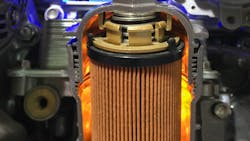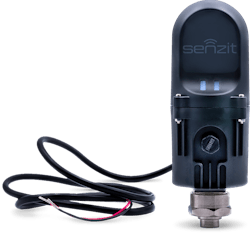Identifying the right filter, and maintenance solution, for your fleet
Filter maintenance strategies used to be reactive. A fleet would find out whether it had a good or bad filter after changing it out during the normal replacement interval, or in the worst-case scenario after a system failure. Those days are gone. Through advanced sensor technologies and data analytics, fleets can now better maintain filters, ensure they are working at optimal levels, and predict failure before a crisis arises. In short, these tools help fleets not only achieve better air and fluid flow, but a better workflow as well. At the end of the day, the best filter maintenance program comes down to visibility, said Chris Scott, CEO of Senzit, a provider of smart engine monitoring devices.
“Fleet managers need a quick and easy way to view the performance of their equipment in the field to make better decisions,” Scott said. “They’re tasked with maintaining steady state operations. And one study found filtration being a cause for about 50% of all downtime. That’s why it’s critical to know what’s happening underneath the hood and in your filtration system.”
Due to sensor innovations, that visibility includes foresight—seeing potential issues ahead of time and keeping broken equipment from clogging up maintenance bays. Scott said the industry has seen the overarching shift from reactive to preventive maintenance, and the trend has been magnified over the last few years due to COVID, the labor shortage, and the supply chain crisis.
Today, best-in-class businesses are turning to new filter solutions to maximize their operations, from monitoring engine, air, and oil filters to analyzing how filter replacement intervals have fluctuated. They won’t all make sense for every fleet, but knowing what is out there should help fleets see where their filter program’s future could go.
Where do you start?
Before getting into the high-tech monitoring solutions, a fleet needs to first select the filter itself.
Filter media play a big role in ROI. According to Nate Neudecker, product manager of engine air aftermarket at Donaldson, the filter manufacturer found that a fleet of 600 or more trucks could save $100,000 annually using its premium PowerCore air filters. Donaldson claims these media offer 13% to 26% better dust-loading than competitor brands, with 27% to 49% lower initial restriction. Better air flow equals better fuel efficiency and fewer filter changes.
Neudecker recently wrote in a Fleet Maintenance column that “your air filtration system collects harmful particulate that could significantly reduce engine performance, if not cause catastrophic damage. The pros of air filtration obviously outweigh the cons by a significant amount. Efficient, effective air filtration is a must, whether you’re managing an on-road or off-road fleet.”
He added that “Donaldson research has shown that you could be sacrificing 13% to 35% of your dust-holding capacity with a cheaper air filter.”
Chris Reamsnyder, VP of sales at Dorman Products, explained that filtration media impacts capacity, efficiency, and restriction. And the containers for these media have gone through a lot of innovation.
“Many of the liquid systems have transitioned to patented cartridge-style designs, while others have maintained a spin-on configuration but have incorporated unique mounting plates,” he said, adding that “spin-on” filters that use a common thread size are becoming less common. “Regardless, most are using a greater percentage of synthetic-based fibers in the media to improve filtration performance and drive toward extended drains.”The complexity to extend intervals has also increased their price.
Air filters have also changed, Reamsnyder noted. “Axial load filters transitioned to radial seal filters, and now the trend is aligning with channel media versus traditional pleated designs.”
Both the channel style and precision pleat equivalent have allowed filter makers to optimize the media density, he said. “In doing so, the size of the filter has been reduced significantly while ensuring the same level of life/capacity,” he said. “Further, constraints on filter shapes have been redefined. As expected, the new technology comes at an expense, and patents have limited competitive alternatives.”
Donald Chilton, director of product management at MANN+HUMMEL, the parent company of Senzit and WIX Filters, agreed that filter media innovations have increased in recent years.
“The important thing to know is that this cannot always be seen by the eye, but rather, the results show in the performance on the road and in the lab,” he said.
For example, the design of the Spin Flow Technology in the WIX XD oil filter uses angled fins to start the filtration of heavy particles away from the oil. Chilton said bigger particles are spun down and trapped, which provides an extra layer of protection.
WIX also recently launched the ProTec oil filter line, providing up to 96% or more containment-trapping capabilities for passenger vehicles and light trucks, the company said. This elevated design allows for an extended period between oil changes, as the previous version provided engine protection for just 3,000 to 5,000 miles.
Improving PMs to increase uptime
A proper PM strategy must complement these innovative new filters.
“Having a well-planned maintenance schedule, as it pertains to filtration, ensures fleet uptime,” Dorman’s Reamsnyder said. “It starts by aligning with a strong distribution or installer partner that knows your fleet and will have the parts ready when you need them.”The responsible maintenance provider should also translate the filter maintenance onto software or spreadsheets to provide reminders of when PMs are due. Tracking power unit miles or hours, depending on the vehicle and duty cycle, will also help the shop prepare for filter change-outs and ensure parts and labor are both standing by when the truck rolls into the bay.
“Essentially, plan your work, then work your plan,” he advised. “In doing so, you will ensure uptime and optimize profitability.”
One air filtration trend Reamsnyder warned against was getting ahead of schedule and changing filters too frequently.
“Some may believe that it is better to change the air filter more often than required,” he said. “This is poor practice. Not only do you increase the probability of introducing contaminants every time you remove the filter from the housing, an air filter is most efficient after a ‘dust cake’ is formed on the surface of the media.”
Garco Construction didn’t have a strict maintenance program in place and had little visibility into the condition of their air filters. The company, headquartered in Spokane, Washington, with a mixed fleet of more than 200 machines, relied on manual engine hour tracking and changing the air filter whether the machine needed it or not. This practice meant fleet management didn’t necessarily correspond to the actual condition of Garco’s machines, increasing the likelihood of scheduling service too early or too late.
They chose the Senzit monitoring solution that maximizes filter use and efficiency, and helps fleets avoid premature or delayed replacement of filters. By retrofitting Senzit sensors to their entire fleet, Garco could view each filter’s dust load and remaining life in Senzit’s web portal or mobile app, then schedule service as needed. Whether in the garage or on the job site, a technician could service the equipment with minimal downtime and ensure better asset utilization.
Senzit helped Garco leave old maintenance practices behind, and the company can now calculate downtime more accurately.
“Over the past year, we have been able to calculate a 75% reduction in unplanned downtime,” said Mark Masterman, Garco’s shop foreman.
He also mentioned increased visibility has helped to put more time into his schedule.
“It’s all right there on the screen, which drastically cuts down the hours I would spend trying to find this information and then being able to schedule my guys to do the work,” Masterman said.
Senzit’s Scott said since Garco’s success, the company launched its Generation 2 unit, which is rugged and robust enough to match the harsh environments where the equipment operates. He said the company has been able to use Senzit sensors to collect all the data points and enhance the physical product, software, and predictive algorithms associated to filter health.
Optimizing intervals
Thomas Walsh, MAHLE head of aftermarket filtration, North America, said advances in fluid, filtration, and engine technology have helped to extend oil change intervals.
For example, prior to the change to FA-4 and CK-4 engine oils, heavy-duty trucks would require an engine oil change about every 15,000 to 20,000 miles. With the introduction of synthetic oils and filters to address needs in improving fuel efficiency, OEMs now recommend a 50% to 65% longer oil drain interval.
These longer intervals provide fleets more time on the road and less money spent maintaining their vehicles.
Walsh noted that commercial vehicles that use synthetic oil and premium filters can typically use oil filters with extended intervals. But there are factors that could reduce these intervals.
“Driving conditions should also be kept in mind when monitoring length between oil changes,” Walsh added. “Long periods of idling, extended towing, or driving in dusty conditions are just a few of the reasons that could contribute to premature oil and filter wear.”
The introduction of synthetic oil to the market is a main factor in the ability to have extended filter change intervals, he explained. Synthetic oil does not break down as quickly as standard oil. However, with the increase in the length of intervals between oil changes comes the need for better oil filters.
“As synthetic becomes the standard option for many vehicles, a premium filter is needed to truly achieve the extended intervals,” Walsh said. “A premium filter also helps protect engines better from contamination and keeps the oil cleaner, allowing for less wear on internal engine components like bearings and cylinder walls. The positive benefits a premium filter has on the engine lubrication system far outweigh the few dollars it costs to upgrade the filter.”
Walsh said while extended intervals are a great way to save money on short-term and long-term maintenance for fleets, it cannot replace checking the oil on a regular basis.That’s where advanced technology and cloud-based tools come into play for fleets looking for preventative maintenance solutions.
Brian Bressler, director of powertrain aftersales at the Paccar Technical Center, said his company has run several tests in their own facilities to determine the best intervals for oil and fuel changes.
“We do a lot of durability-type testing—to check the engine’s durability and reliability, dependability, and expectations.” Bressler said. “And in that process, we’re constantly monitoring the fuel filter and the oil filter and determining what the best interval to change it would be based on those types of tests.”
Bressler said what goes inside of the filter is essential for capturing debris, monitoring flow rate, and controlling the combustion byproducts to ensure “junk” isn’t going into the oil. For the types of analysis completed on the oil and after a long-term test is done, he said the engine is taken out of the truck, broken down, and each different part is looked over to make sure that it’s still reading with original expectations.
Even with factory-level testing, fleets themselves must not become complacent and should verify with their own testing, warned Dorman’s Reamsnyder. “Just because a filter company advertises extended drain intervals doesn’t implicitly imply that you can, or should, extend drain intervals,” he said. “The oil must also be monitored to ensure feasibility from the perspective of wear and degradation.”
Monitoring solutions
Once you know the filter(s) for fleets that use multiple resources on their trucks, then comes the solution to monitor and analyze what’s going in and how it’s coming out. As an alternative to manual tracking, several solutions on the market today are centered around gathering the right data electronically and sending it to the cloud for analysis. This, in turn, enhances predictive and PM efforts in the shop.
Here are a few options:
Senzit platform
Senzit’s Scott said a lot of customers look for a solution because they’ve experienced a significant downtime event, such as dusting an engine. Scott explained dusting an engine is when a particulate escapes the filter and enters the engine, which often leads to damage and potential catastrophic failure that can leave equipment useless.
That is where Senzit can provide visibility, working as a constant monitor for equipment filtration. Scott said based off real-time filter load data and the recommended terminal pressure set by the manufacturer, Senzit maximizes filter use and efficiency and helps fleets make sure they don’t replace a filter too early or too late.
Scott said the Senzit sensors are a plug-and-play solution. The sensors are hooked up to the engine filter’s service port, and all the generated data is sent to the cloud via 4G LTE. The data is then transformed into readily available actionable insights.
“We’ve seen strong results, such as a 75% reduction of unplanned downtime from one of our key accounts,” he said, referring to the Garco study.
According to Scott, Senzit takes preventive maintenance one step further by enabling predictive maintenance.
FleetguardFIT | Cummins Filtration
Cummins Filtration’s FleetguardFIT solution provides shops with real-time status updates on the health of consumables, allowing maintenance and inventory managers to decide if the useful life of a consumable could be extended past its normal service interval.
FleetguardFIT is made up of both software and hardware. Smart sensors installed on an engine collect filter and oil data, which is then sent to a secured FIT cloud. The data is analyzed and sent back to the FleetguardFIT Portal, mobile app, or the customer’s portal via API. The solution works on Cummins as well as non-Cummins engines.
The customer receives diagnostic information and prognostic insights to continue preventive maintenance measures. Shantanu Nadgir, business development manager at Cummins Filtration, said this helps the customer fully utilize the filter life and reduces the need for replacement filters.
“With this solution, the customer will not need as many filters as they did before without FleetguardFIT solution, helping them alleviate the supply chain issues,” Nadgir said.
He said customers have given positive feedback about the ability to optimize service intervals and reduce planned maintenance costs with the FleetguardFIT solution.
“The demand to maximize uptime, reduce maintenance costs, extend equipment life, and reduce the carbon footprint is becoming increasingly more important to customers,” he said. “And we’ve seen that FleetguardFIT capabilities allow customers to do that.”
Filter Minder Connect | Donaldson
“It’s no secret that almost every industry you can think of is feeling supply constraints,” said Nate Zambon, director of Filter Minder at Donaldson. “Knowing that, fleet managers need to make sure they have the right parts at the right time and in the right location. Filter Minder Connect and MyGeotab allow that to happen. By giving forewarning of when you need to change a filter, fleet managers can plan accordingly to make sure they have what they need.”
Zambon said most of the time, maintenance was scheduled based on the oil or filter change date. This led Donaldson to find that air filters were being changed no matter how many miles had been put on them. In some cases, there was 80% life left on the filter.
“We found that this process can be optimized to give fleet managers more control,” he said. “Now they can get the most out of their filters by only changing them when needed, saving time and money.”
The Filter Minder Connect sensors and receiver wirelessly transmit performance data to the cloud, and predictive analytics inform users when filters and engine oil are approaching the end of their optimal life. Fleets can make it even easier to monitor filtration systems and oil when they use Geotab and Filter Minder Connect combined.
“MyGeotab is the primary platform that fleet managers use to understand all aspects of their fleet,” said Scott Sutarik, VP of Enterprise Solutions at Geotab. “From GPS tracking to engine health and maintenance, fleet managers have access to relevant data that can better equip them to generate new opportunities for growth and savings.”
Zambon said Filter Minder Connect and MyGeotab can also help detect issues sooner than usual. “For example, if coolant leaks into the engine and is not identified, it can lead to complete engine failure,” Zambon concluded. “By having access to real-time data, you can address it before it becomes a major concern.”
Filter media
Thomas Walsh, MAHLE head of Aftermarket Filtration, North America, explained that the different types of filters allow for different levels of change intervals.
Cellulose filter media is the most common filter media and is paper based, allowing for oil change intervals between 3,000 and 5,000 miles.
Synthetic filter media is a high-quality or premium media produced from a variety of compounds and polymers, allowing for oil change intervals between 5,000 and 10,000 miles, depending on OEM guidelines.
Microglass filter media is the highest quality media for oil filters and is produced with extremely fine metal media or a fiberglass type of media. Walsh said these filters allow for intervals above the 10,000-mile threshold, but should only be used if recommended by the OEM.
About the Author

Faith Boone
Faith Boone has more than 15 years of experience as a journalist, public relations professional, strategic marketer, and entrepreneur. She has held several positions within the communications industry, and also enjoys giving back to the community through her work with various non-profit organizations. She is the founder of Boone Logic, a Cleveland-based content development and marketing consultancy.



